How Immigrants Are Inspected at Ellis Island
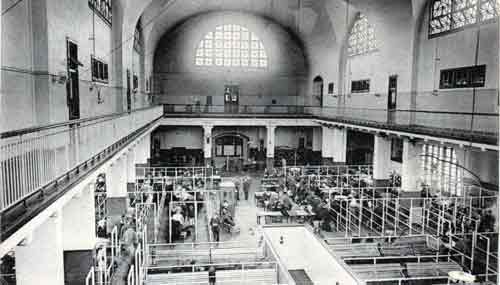
The Registration Room at Ellis Island. Inspection of Our Immigrants May Be Said to Begin in Europe. The Immigrant Usually Buys His Steamship Ticket in His Native Town from an Agent or Subagent of the Steamship Company. Postcard Image circa 1905. GGA Image ID # 1d9e07ed04
The agents of the best steamship lines are held responsible by the company for the passengers they book for America, and if they ship one of the excluded classes, they are likely to lose their agency.
This policy makes the agent examine the applicants for tickets, and probably many prospective immigrants are refused passage by agents of the first-class lines. These prospective immigrants then usually try some less particular and smaller lines and take chances of escaping inspection at the Canadian or Mexican borders.
The subsequent scrutiny to which the immigrant is subjected is that of the steamship authorities at the port of embarkation. This examination was formerly cursory and is so still, as far as some lines are concerned, but first-class lines, notably the English and German, scrutinize the immigrants and with due regard for our laws.
The strict enforcement of our laws, and especially the imposition of a one hundred dollar fine for bringing to our ports any ease of a contagious character, have occasioned some improvement in the inspection made by ships' doctors at European ports.
At the port of embarkation, the immigrants' names are recorded upon lists or manifests, each containing about thirty names. After each name, the steamship officials are required by law to record answers to a certain number of queries relating to the immigrant.
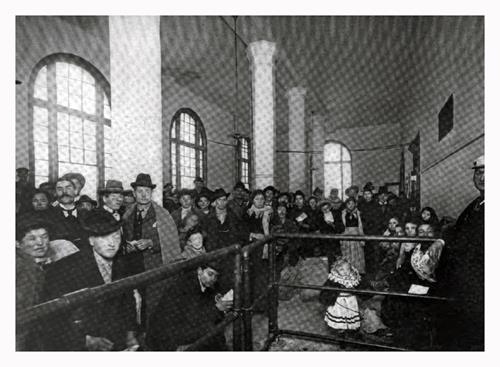
The Receiving Room at Ellis Island Where Alien Immigrants First Land, 1904. GGA Image ID # 1d9e182b57
1903 Passenger Manifests
Section 12 of the act of 1903 provides that the manifests shall state, in answer to the questions at the top of the manifest sheet:
- The full name, age, and sex;
- whether married or single;
- the calling or occupation;
- whether able to read or write;
- the nationality;
- the race;
- the last residence;
- the seaport of landing in the United States;
- the final destination, if any, beyond the port of landing;
- whether having a ticket through to such final destination;
- whether the alien has paid his own passage, or whether it has been paid by any other person or by any corporation, society, municipality, or government, and if so, by whom;
- whether in possession of thirty dollars and if less, how much;
- whether going to join a relative or friend and if so, what relative or friend, and his name and complete address;
- whether ever before in the United States, and if so, when and where;
- whether ever in prison or almshouse or an institution or hospital for the care and treatment of the insane or supported by charity;
- whether a polygamist;
- whether an anarchist;
- Whether coming because of any offer, solicitation, promise or agreement, expressed or implied, to perform labor in the United States, and
- What is the alien's condition of health, mental and physical, and whether deformed or crippled, and if so, for how long and from what cause.
The master or first officer and the ship's surgeon are required by the same law to make an oath before an immigration officer at the port of arrival that the lists manifests are to the best of their knowledge and belief true and that none of the aliens belongs to any of the excluded classes.
Alien Identification Cards
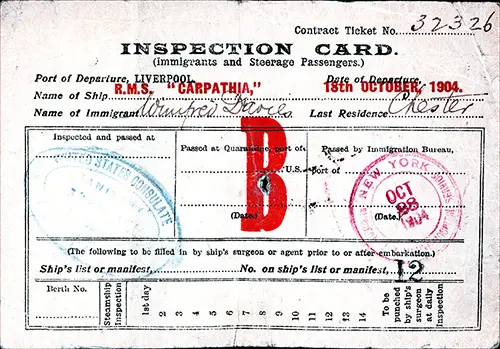
Inspection Card for Immigrants and Steerage Passengers, for an Immigrant on the RMS Carpathia, 18 October 1904. GG Archives Immigration Archival Collection. GGA Image ID # 1d9e86158d
Each alien is furnished with a card with his name, the list on which his name appears, and his number on that list. The cards of minor children are given to the head of the family. These cards are valuable and necessary for identification and facilitate inspection at the port of arrival.
Conditions on Steamships
The condition of the steerage quarters of a modern steamship depends mainly upon the ship's age and the degree of overcrowding. The steerage of a first-class ship of recent construction will afford accommodations equal to those accorded second cabin passengers on less progressive lines.
First-class lines are also careful to prevent overcrowding. The accommodations are limited on some smaller and older ships, and overcrowding is permitted. But it is safe to say that the worst steerage accommodations to be found on any ship entering New York harbor today are infinitely better than the best afforded by the sailing vessels or old 'side wheelers' of the past.
Inspectors Boarding of Ocean Liners
The state quarantine authorities board the ocean liners on entering New York harbor. The immigrants were inspected for quarantinable diseases, such as cholera, smallpox, typhus fever, yellow fever, or plague.
Then the immigrant inspectors and a medical officer of the Public Health and Marine Hospital Service board the vessel and examine the cabin passengers, paying particular attention to the second cabin.
This cabin inspection is essential, and, before its institution, the second-class cabin was the route most often employed by persons who found it necessary to evade the law. After completing the cabin inspection, the ship's surgeon reports any cases of sickness among the aliens in the ship's hospital.
The medical inspector examines these cases and later arranges for their transfer, if deemed advisable, from the ship to the immigrant hospital. The immigrants are then taken from the ship upon barges to the immigrant station, Ellis Island.
Medical Examination at Ellis Island
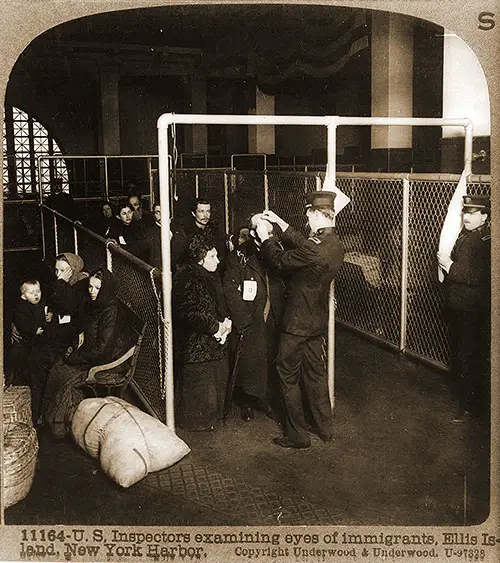
U.S. Inspectors Examining Eyes of Immigrants, Ellis Island, New York Harbor. Works and Studios, Arlington, N.J., Westwood, N.J. Underwood & Underwood, Publishers, c1913. Library of Congress LCCN 97501532. GGA Image ID # 1d9ef04320
The medical examination at Ellis Island is conducted according to a system resulting from many years of development. The doctors work in pairs and divide the inspection between them.
The immigrants, coming in single file, are examined for certain defects by the first doctor, who detains each one long enough to keep a space of ten to fifteen feet between the immigrants.
The second doctor, placed about thirty feet from the first, disregards that part of the examination entrusted to his colleague and confines his examination to such defects as are not looked for by the first doctor.
The file of immigrants makes a right-angle turn just as it reaches the second doctor, enabling the examiner to observe the side and back of the passenger in the shortest time possible.
The examiners follow a routine in this examination, and the scrutiny begins at the approaching passenger's feet before he comes within fifteen feet of the examiner.
The examiner's scrutiny beginning at the feet travels upward, and the eyes are the last to be inspected. In this way, lameness, deformity, defective eyesight (through efforts to adjust his vision after turning to a new course) are detected.
The gait and general appearance suggest health or disease to the practiced eye, and aliens who do not appear normal are turned aside, with those who are palpably defective and more thoroughly examined later.
The medical examiners must ever be on the alert for deception. The nonchalant individual with an overcoat on his arm is probably concealing an artificial limb.
The child strapped to its mother's back and who appears old enough to walk alone may be unable to walk because of infantile paralysis.
One may so skillfully prepare a case of favus for inspection that scrutiny is required to detect the evidence of a recent cleansing.
A bad case of trachoma may show no external evidence and be discovered only upon inverting the eyelid.
After the last alien in line has passed the doctor, the suspected ones turned aside are thoroughly examined, idiots and those suffering from a loathsome or dangerous contagious disease are certified and sent to the Board of Special Inquiry.
Cases not deemed fit to travel are sent to the hospital. Patient cases with some disability likely to make them a public charge are certified accordingly and sent over to the Board of Special Inquiry.
Minor defects, such as anemia, loss of an eye, loss of a finger, weak physique, low stature, etc., are recorded on the alien's card. He is allowed to go to the registry clerk and immigrant inspector in charge of the manifest, who considers the defect as contributory evidence and may or may not send him to the board.
Grouping of Immigrants
After passing the doctors, the immigrants are grouped, according to the number of their manifest sheet, into lines of thirty or less. At the head of each line is a registry clerk, or interpreter, and immigration inspector.
The clerk or interpreter interrogates each alien, finds his name, and verifies the answers on the manifest sheet before him. Suppose, in the opinion of the immigrant inspector, the immigrant is not clearly and beyond a doubt entitled to land. In that case, he is held for the consideration of the Board of Special Inquiry.
Board of Special Inquiry
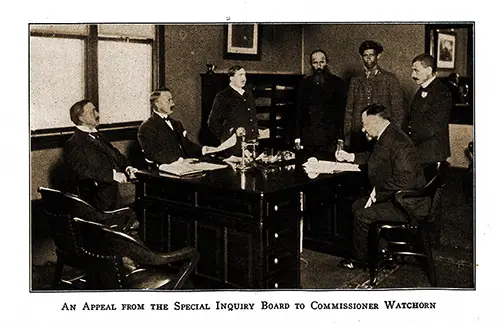
An Appeal from the Special Inquiry Board to Commissioner Watchorn. Aliens or American, 1906. GGA Image ID # 20c2f9680c
A board of Special Inquiry according to the law of 1903 consists of three members selected from such of the immigrant officials in the service as the commissioner-general of immigration, with the approval of the secretary of commerce and labor, shall designate as qualified to serve on such boards.
The decision of any two board members shall prevail and be final. Still, either the alien or any dissenting member of the said board may appeal through the commissioner of immigration at the port of arrival.
The commissioner-general of immigration to the secretary of commerce and labor, whose decision shall then be final, and the taking of such appeal shall operate to stay any action regarding the final disposal of the alien, whose case is so appealed, until receipt by the commissioner of immigration at the port of arrival, of such decision.
This Board of Special Inquiry is sent the aliens certified by the medical officers as suffering from loathsome or dangerous contagious disease, idiocy, epilepsy, and insanity.
Deportation for Unfit Immigrants
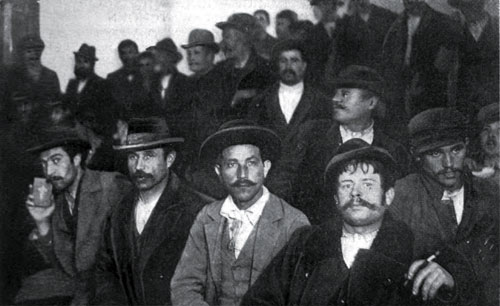
Detained Aliens Awaiting Deportation at Ellis Island. Rising Tide of Immigration, 9 September 1905. GGA Image ID # 20c3127d77
In cases so certified, the law is mandatory, and the medical certificate is equivalent to exclusion, the board merely applying the legal process necessary for deportation.
Aliens certified by the medical officers as suffering from a disability, likely to make them public charges, are also held for examination before the Board of Special Inquiry.
In these cases, the board considers the medical certificate and such evidence as may be adduced by the alien or his friends, which, in the opinion of the board, would offset the physical disability. In these cases, the board has full discretionary powers, and in most instances, the alien is admitted.
Those certified as defective by the doctors' group themselves naturally into four classes. The following table indicates the disposition of such cases by the Boards of Special Inquiry at New York during a fairly typical month.
Disposition of Immigrants Certified at Ellis Island, New York
Month of October, 1903
Class I (Dangerous Contagious)
- Cases pending beginning of month: 10
- Cases certified during month: 83
- Total to be accounted for: 93
- Cases deported: 61
- Cases landed: 4
- Cases pending close of month: 28
Class II (Insanity and Idiocy)
- Cases pending beginning of month: 0
- Cases certified during month: 1
- Total to be accounted for: 1
- Cases deported: 1
- Cases landed: 0
- Cases pending close of month: 0
Class III (Loathsome)
- Cases pending beginning of month: 0
- Cases certified during month: 1
- Total to be accounted for: 1
- Cases deported: 1
- Cases landed: 0
- Cases pending close of month: 0
Class IV (Likely to Become A Public Charge)
- Cases pending beginning of month: 30
- Cases certified during month: 393
- Total to be accounted for: 423
- Cases deported: 30
- Cases landed: 349
- Cases pending close of month: 44
New Immigrants Passing Inspection
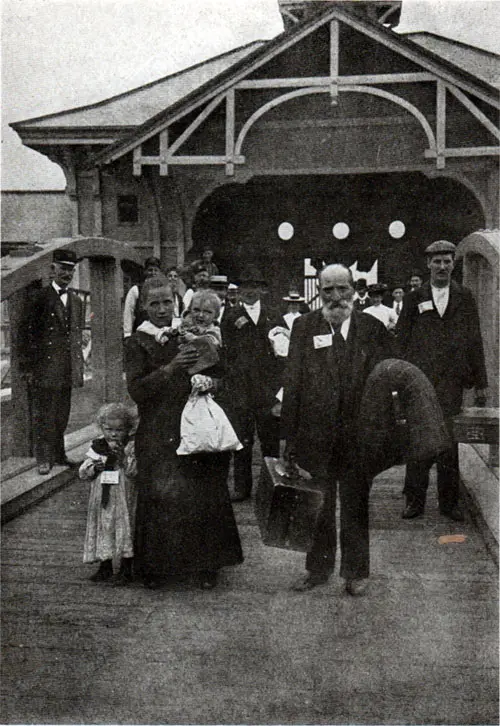
New Immigrants Entering America from Ellis Island. GGA Image ID # 20c342f64a
Immigrants not detained for the Board of Special Inquiry have their money changed into United States currency and buy their railroad tickets under the supervision of government officers.
If they are destined to points beyond New York City, government supervision is maintained until they are taken to one of the great railroad terminals and placed upon the waiting train.
These precautions are taken to protect the immigrants from the boarding house runners' and other con men who lie in wait for them at the Battery. Aliens detained as not clearly entitled to land are brought before the board, and if the evidence is complete, either deported or discharged.
When the evidence is incomplete, the immigrant is detained pending the verification of his story or the arrival of his relatives or friends.
All cases are disposed of as rapidly as possible, and immigrants are detained the minimum amount of time required for procuring and carefully considering the evidence in the case.
Those ordered deported are returned to the ship as soon as possible after the decision is rendered, providing no appeal is made.
Organizations and Representatives Meeting Immigrants
Missionaries and representatives of various religious denominations and societies have offices upon Ellis Island and render immigrants valuable assistance.
They provide temporary shelter and protection for discharged aliens and direct them to legitimate employers of labor. In this way, they relieve the government of caring for many temporarily detained aliens, especially young women traveling alone.
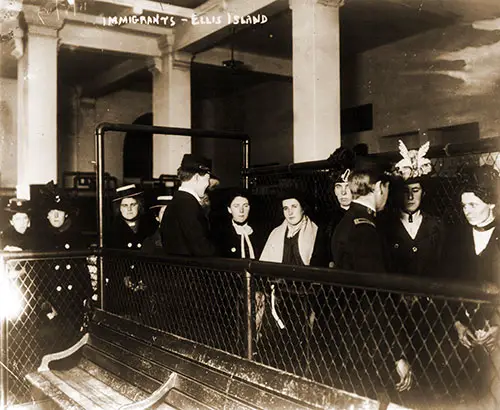
Line of Female Immigrants Undergoing Inspection at Ellis Island circa 1912. Bain News Service. Library of Congress LCCN 2001704437. GGA Image ID # 1d9f02122b
They write letters and send telegrams to the friends of the detained immigrants and assist them in many other ways.
Summary
The fine adjustment of details and perfection of the system which enable the federal officers at Ellis Island to examine, under our laws, thousands of aliens each day must be seen to be fully appreciated. Nor is this careful and strict execution of our laws limited to Ellis Island.
The writer has roughly described the inspection at New York because it is our largest port of entry. Still, the same attention to detail and strict enforcement of laws and regulations can be said to exist at all our ports. An investigation, by anyone interested, will reveal the fact that not only are the laws for our protection strictly enforced, but their enforcement is marked by humane and kindly treatment of the Alien.
Source: The Popular Science Monthly, February 1905, Volume 66, Pages 357-361. Photographs from the GG Archives Immigration Collection and the National Archives (NARA). Editied for grammar, spelling, and sentence structure.
